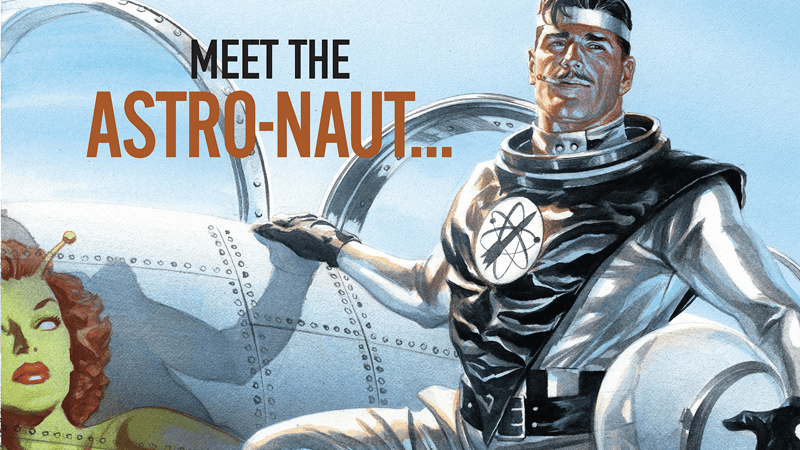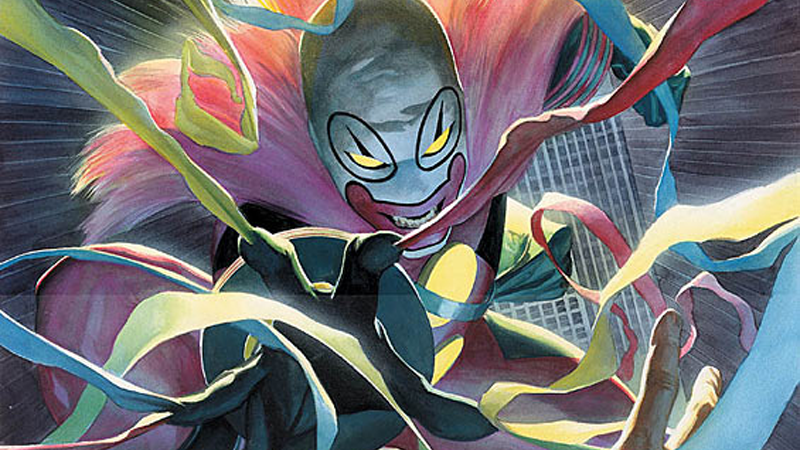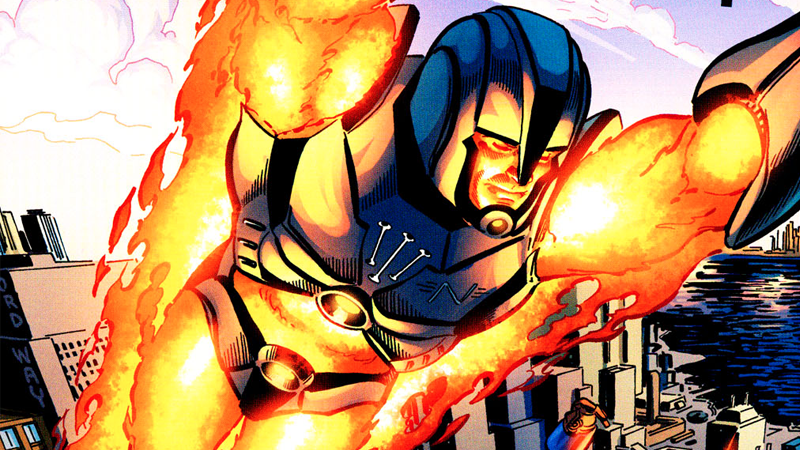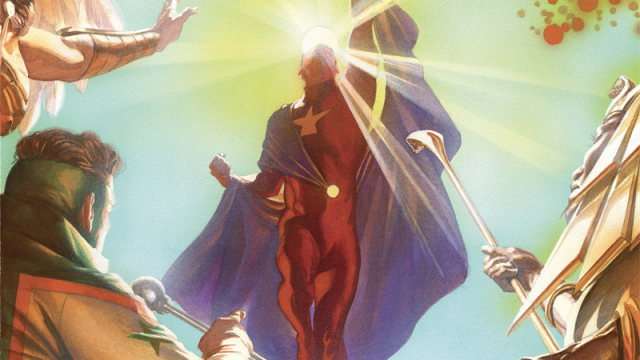This week, one of the most important superhero stories in comics reached a major milestone: Although it might say issue 41 on the cover, this week’s Astro City marks the 100th issue of Kurt Busiek, Brent Anderson, and Alex Ross’ groundbreaking series. To celebrate we sat down with Busiek to talk about the series’ legacy, and where it’s headed next.
Image: Astro City #41 Variant Cover art by Alex Ross.
io9: When you first started out on Astro City, did you ever think you’d get this far? What’s it been like reflecting on the legacy of the series now that the 100th issue is out?
Kurt Busiek: When Brent [Anderson] came on the series and became our regular penciller, he said, “I’ll draw it for 100 issues, or 10 years — whichever comes first.” And everybody laughed. Because those were such ridiculous numbers to be drawing around. And now, 10 years came and went, and we’re up here at 22 years and thanks to having guest art here and there, Brent hasn’t quite done 100 issues, but — we just kept going. We just kept putting one more page on the stack, one more story on the pile and slowly but surely got here. But at no point was I thinking, “Ah yes, when we got to 100 issues…” and I can’t even say I was ever thinking, “Oh no, we’ll never make 100 issues.” Because the support of the audience has been wonderful.
Despite our occasionally crazy production schedule, they have always been there to support the book. When I started the book — when we all started out on it — I had no idea that other people would like it at all. So, the idea that not only would people like it enough for us to survive past six issues, but they would like it enough to arrive to 100 issues and still be going comfortably and strong is amazing to me, in retrospect. But until a couple of years ago, I didn’t actually start thinking “Wow, we’re actually approaching this number.” I just kept my head down and kept writing stories.

Ross’ main cover for Astro City #41
Issue #41 is looking back at the story of the Astronaut and how Astro City got its name. What made you choose or decide to tell this story now? Is it something that you’ve had swirling around in your head for the past few decades?
Well, we knew what the events were. We knew very early on that Astro City had been renamed,and it had been renamed in honour of the Astronaut — who Alex [Ross, Astro City‘s long time cover artist] had a design in mind for. And he’d done sketches for it 20 years ago that I never actually saw, until I started working on this story. He said, “I’m going to start digging out my sketches.” And I said, “Oh! There are some?” And so he modified and reworked them from what he came up with 20 years ago!
But, as with almost everything that happens in Astro City, the story is about something other than the event. In this case, the story is more about a relationship than it is about the specific — we knew that Astro City was attacked after the war, and a bunch of the Midtown area was destroyed. But that’s a small part of Astro City #41. It happens. It affects everything else in the book. But we’re not simply telling the story of that adventure. We’re telling the story of the character issues that swirl around that particular adventure. So, we knew it was part of the history, but I didn’t know specifically what the story would be about until we started planning it. It worked out nicely in that we started looking at issue #100 coming up, looking through this loose arc of stories we’re doing about the Broken Man touring us through the underground history of Astro City. So we said, “OK, we’ll make it part of that story arc. We’ll tie it in to what’s going on as a chapter in that micro-story, but of course it’s also a standalone issue. So it fit nicely in what he already had planned.
It’s fascinating to hear about all these elements that have just been sitting around, and haven’t been discussed for years and years, and then all of a sudden it can be weaved into a story you’re creating in the here and now. That brings me onto the next thing I wanted to ask: Astro City is about stories from so many different perspectives and characters that we meet and leave throughout the course of the entire series, whether they’re heroes or regular citizens or villains. What’s been the biggest challenge for you, as a writer, trying to keep that depth and variety of perspectives, while also keeping the consistency of telling all these different stories over 100 issues of comics?
I think that… it’s something that happens organically, more than anything else. There are times when I take a very analytical approach to what kind of story we are going to do. For instance, the very first six issues we did, I knew I wanted to do a six-issue arc of single-issue stories that would show people in various parts of the city and various parts of the Astro City experience. If we opened the series with a six-part series about the Confessor and Altar Boy, people would have assumed that that was what the series was about — the adventures of these characters. And when issue #7 came along, they’d say, “what are you doing? who are these other guys!?” So, there were very specific reasons behind why we chose, for issue one, to tell a story of some man from his point of view, and issue #2 was a historical story from a reporter’s point of view, and #3 was a Jack-in-the-Box story from a criminal’s point of view. So that by the time we got to issue six, you had the sense that this is what the series is about, the range of it. I’m not going to be confused when the perspective shifts around a lot.
And we do that as we’re going on in the series on a more organic level. You know, we go, “We’ve been telling too many stories that are from the point of view of superheroes, let’s make sure that we come up with a couple that are from the point of view of ordinary people, or from somebody else, who stands to the side, or whatever.” Alex is always there to remind me, “Don’t forget the popular characters. If you haven’t done a Jack-in-the-Box story for a while…do a Jack-in-the-Box story. I love putting him on covers!” And so that sense of just staying aware of balance is part of the process as we go along. And sometimes, there are times when we go, “The last time we saw Astra — from the First Family — she was about 12 years old, and now she’s — she’s 21? Oh. Well, that’s different!”
We let the series proceed in real time. Which means we introduce characters like the Crossbreed as teenagers, and now it’s 20 years later and they’re all in their 30s. So when we see them again, I’ll have to say, “if we’re going to do a story about them as a team of young people, it’s going to have to happen as a historical piece.” Because they’re not young people anymore. In part, me being sick for a number of years lost us opportunities to do stories I would have wanted to do, set in the present at a time when the characters were such-and-such an age. But we have the advantage of being able to jump around in time, so, I can tell those stories anyway. I just have to contextualize them a little.

Jack-in-the-Box art by Alex Ross.
There’s a lot of discussion about the nature of legacy in Astro City, and these mantles of heroes evolving and being passed down to people over time. When it comes to creating a specific hero mantle, is that something you think in advance, “later down the line I’m going to tell a story about another character who uses this title…” — or is that something that just, as you said, grows organically out of the fact you’ve been writing all these stories for over two decades?
I think it’s been more organic. I mean, I didn’t go into this making plans for, you know, “and then 15 years into the series we’ll do such and such”, you know? [Laughs] Because I had no particular belief that 16 years into the series there’d still be an audience wanting to read these things. So, in some cases the legacy is built-in. In that the very first time we saw Jack-in-the-Box in an Astro City story, it was the second Jack-in-the-Box. We knew right from that very first story there had been an earlier one. And the second time we did a Jack-in-the-Box story, it involved his wife being pregnant. So, when we are coming up on 20 years beyond that, it is natural to say, “Well, is his kid going to become a third Jack-in-the-Box?” Is this a development? We need to address it one way or the other. And he’s going to go to college soon. And that became an interesting story to find. In other cases — you know, Samaritan’s not passing his powers onto anybody. At least not so far. So we’re able to pick and choose the legacies that we want to work with and sometimes that’s a matter of noticing it’s a possibility and other times it’s already built in.
I think a lot of what we’re doing with Astro City — at least recently — is less about legacy, because there are a lot of comic books about legacy, you know — DC does those comics about legacy heroes going back to the 40s. What DC doesn’t do that much because of the time situation they’re in, is characters who age. So we have to do a story I just love doing, which is about Quarrel and Crackerjack facing the fact that they’re coming close to being 50 years old. And they’re costumed acrobats. So, that’s a story you’re never going to see in regular continuity in Batman. Regular Batman is not going to be 50 years old. You could do a story like The Dark Knight Returns, where we tell a story where we see him dealing with the fact that he’s aged. But you never got to see his life in-between. It’s often this legendary bubble of “someday.” Whereas in Astro City, we’re having it all the time. The characters we introduced as fetuses are now going to college! And characters we introduced in the prime of their life are now ageing. And being able to deal with those questions, particularly at a time when, you know, 22 years older than I was when we started on Astro City, and I think about questions of ageing and parenting and all the stuff that can fuel those stories. It becomes something that we can do with the series that allows us to deal with material that very few superhero readers have had the chance to see.
Looking back at the series now that we’ve reached a milestone like this — is there a particular storyline that stands out to you as one you’re most proud to have done? I know the perennial fan-favourite whenever you talk to fans of Astro City is “The Nearness of You” as the one people point to. But is there a story in particular that you hold on to?
Well, A lot of them. I think we’ve done pretty well overall. But yeah, I think the Samaritan versus Infidel story “The Eagle and the Mountain” worked out very well to my mind, and still seems to resonate well with the readers today. The single-issue story we did about Beauty, the android life size fashion doll… the story I just mentioned, the Quarrel and Crackerjack story came out much more powerful than I imagined it would be going in. Because there’s a real inevitability to what they’re facing. I mean, I could create a magic fix for it, but it made the story more interesting to just have them deal with it in a human way. So, the stories where I really get to dig into a character’s vulnerabilities, to the point which they can’t really articulate what it is that they care about so much, that drives them to act even though they don’t fully understand the way it drives them — those are the cool stories.

N-Forcer art by Brent Anderson.
We’ve talked a lot about the history and legacy of Astro City — the final question I really wanted to ask is: Now that you’ve reached such an incredible milestone with the series, where do you want to take it all next?
Well, we’re actually thinking about endings. But not in the near future. Astro City is a series that moves so slowly and uses big plot lines that — I mean — our first big storyline started, we made out first mention of the Silver Agent in issue #2. And we paid off that Silver Agent story just before this new, current series started. So, when you’re dealing with another story along those lines, it’s got a couple of different fronts. One of those is the Broken Man in his battle with the Oubor. And the other is Samaritan focusing on the fact that heroes are ageing out, and the people who are replacing them are — it’s not like it’s a problem he has to think about, that his career has been spent dedicated to making the world better, but the world doesn’t actually seem much better. When we bring these two threads to a head that may well be the end of the series. I mean, we’re going to have to end it at some point. But it will take us quite a while to get there!
In the near future, we’ve got the Broken Man’s tour through history to finish. There’s three more issues of that coming. We’ve got guest-artist issues coming from Matthew Clarke, who did a gorgeous story about a supervillain; Rick Leonardi who did a story about — believe it or not! — a super detective cat. And we’ve got a story coming up that’s very strongly inspired by the political issues and thread of resistance that’s going on in the US today. There are stories… you commented early about enjoying hearing about how a story was finally being done after sitting around for years. The next story that we start plotting out — our next multi-issue story, rather — is going to be a story that’s part of the Astro City plan since the original series proposal. It’s there in the pitch, and we just never managed to get around to it. So everybody who has been asking the question, “When are you going to tell us something about the N-Forcer?”, we’re going to tell you a lot about the N-Forcer. I think that people will like what’s coming. That’s a story that goes back to before… I mean, that’s a story I had kicking around in my head from the moment the idea of doing an Astro City series first arose. We’re finally doing that. So, as usual we have a mix of stuff — keeping the perspectives moving around and keeping everything with variety, as we stumble forward into the future.
Astro City #41 is available now.
